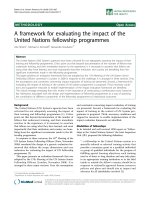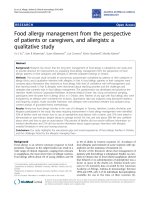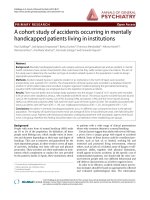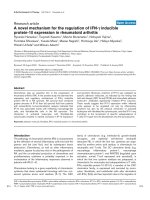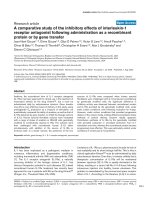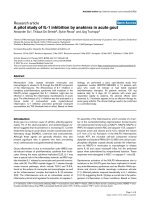Báo cáo y học: "A case study evaluating the use of clozapine in depression with psychotic feature" docx
Bạn đang xem bản rút gọn của tài liệu. Xem và tải ngay bản đầy đủ của tài liệu tại đây (220.36 KB, 6 trang )
BioMed Central
Page 1 of 6
(page number not for citation purposes)
Annals of General Psychiatry
Open Access
Case study
A case study evaluating the use of clozapine in depression with
psychotic features
Premkumar Jeyapaul*
1
and Ray Vieweg
2
Address:
1
Wimborne and Purbeck community mental health team, Oakley bungalow 15 Oakley Lane, Canford Magna, Wimborne, Dorset, BH21
1SF, UK and
2
The Beeches, St James Hospital, Portsmouth, Hampshire, PO4 8LD, UK
Email: Premkumar Jeyapaul* - ; Ray Vieweg -
* Corresponding author
Abstract
The purpose of this case study was to use an evidence based medicine approach to
work through an unusual way of treating a common problem. We looked at an example
of an in-patient with severe refractory psychotic depression who had been resistant to
treatment with a combination of antidepressant, antipsychotics, mood stabiliser, and
concomitant ECT therapy.
We then undertook a literature search for the use of clozapine in a patient with severe
refractory depression.
Although the resulting evidence was low level and thin, we felt on balance that a trial of
clozapine was justified.
We used a BPRS inventory to monitor her mood prior to commencing clozapine. Her
mood and functional abilities were monitored as her clozapine was titrated upwards.
Our patient showed a significant improvement in mood and functional abilities and a
reduction in her BPRS score during this period. Her symptoms improved to the point
where she was successfully discharged home on a combination of clozapine and an
antidepressant.
The improvement was sustained for a further two years.
We thought this was an important case to highlight the limited evidence in using this
successful form of treatment for a common clinical problem and that further research
in this area was needed.
Published: 29 November 2006
Annals of General Psychiatry 2006, 5:20 doi:10.1186/1744-859X-5-
20
Received: 11 September 2006
Accepted: 29 November 2006
This article is available from: />© 2006 Jeyapaul and Vieweg; licensee BioMed Central Ltd.
This is an Open Access article distributed under the terms of the Creative Commons Attribution License ( />licenses/by/2.0), which permits unrestricted use, distribution, and reproduction in any medium, provided the original work is properly
cited.
Annals of General Psychiatry 2006, 5:20 />Page 2 of 6
(page number not for citation purposes)
Background
We present a case study using the Evidence Based Medi-
cine approach and have attempted to work through a
common problem. The aim of the process was to under-
pin our clinical decision with relevant research evidence.
Case
A 39-year-old married housewife with 2 children aged 16
and 12 years was electively admitted for treatment of
worsening depression.
She had a 5-year history of recurrent severe depressive epi-
sodes; there had been no history of mental health prob-
lems prior to this. She had been an in-patient for most of
the last 5 years, and had required one-to-one nursing on
one admission because of self-harming behaviour, which
included cutting and trying to set herself on fire.
She had been raped at the age of 12 years; however, prior
to her first episode of depression she had a well-adjusted
pre-morbid personality, having not had any symptoms
suggestive of post traumatic stress disorder prior to her
history of depression. A diagnosis of post traumatic stress
disorder had been considered, however, rejected because
her depressive affective symptoms dominated her clinical
presentation, and she did not suffer flashbacks to her
index traumatic episode. Other diagnoses that merited
consideration included schizoaffective disorder and bipo-
lar disorder, however, she did not suffer from first rank
symptoms of schizophrenia or hypomanic/manic epi-
sodes which excluded her respectively from both of these
diagnoses according to ICD-10.
The depressive symptoms followed soon after a triggering
event of a horse-riding accident from which she suffered
concussion. A CT scan at the time was reported as normal.
She had a family history of mental disorder, with a sister
who suffered from schizophrenia.
During this present admission she had experienced 5-
month deterioration in mood. She had a 1-week period of
insomnia and increasing suicidal ideation. There was no
history of alcohol/substance misuse or any medical prob-
lems. She had been receiving ECT treatment twice weekly
in the community for the 4 months preceding the admis-
sion. The ECT continued after she was admitted. Her med-
ication was:
Lithium carbonate 1000 mg once daily
Mirtazapine 60 mg at night
Olanzapine 20 mg at night
Chlorpromazine 50 mg at night
On MSE, she had psychomotor retardation with poor eye
contact and a constant rocking motion. Her affect was
melancholic. There was no formal thought or perceptual
disorder, or evidence of cognitive impairment.
On 13/8/01 she was started on a 4-day course of dexame-
thasone, which is an unusual but published treatment for
resistant depression (Dexamethasone augmentation in
treatment resistant depression Acta Psychiatr Scan 1997;
95 58–61). There were no obvious beneficial effects, and
she still felt low in her mood, now with a blunted affect.
Her speech was slower and more monotonous. She had
decreased motivation. She had worsening suicidal idea-
tion.
On 19/8/01 the patient became very agitated and started
lashing out. Several staff members were needed to restrain
her and she was sedated with IM lorazepam. The follow-
ing day she reported hearing voices of her rapists saying
derogatory comments to her.
The patient's mirtazapine, chlorpromazine and olanzap-
ine medication were stopped and she was started on
haloperidol and amitriptyline. Two days later, she started
experiencing second person auditory hallucinations of the
rapist who assaulted her in her childhood. She became
more restless and agitated. Her suicidal ideation increased
and she had difficulty thinking clearly. She continued to
receive ECT treatment and her medication was increased
to 200 mg amitriptyline and 40 mg of haloperidol.
Formulating an Evidence Based Medicine question
We felt it was important to formulate an EBM question
that could be researched in view of possible treatment
approaches that we could offer. We had already tried her
on a variety of medical treatments, which had limited
benefit.
The question formulated was as follows: 'In a patient who
has depression with psychotic symptoms, is the use of clozapine
and an antidepressant more beneficial than standard treat-
ments for psychotic depression, in improving mood and psy-
chotic symptoms.'
Literature search
The literature search that was conducted used the follow-
ing databases:
Cochrane Database, ACP Journal Club, CCTR, 1986–
2002
Medline 1966–2002.
Annals of General Psychiatry 2006, 5:20 />Page 3 of 6
(page number not for citation purposes)
EMBASE 1993–1996.
PSYCHINFO 1887–2002
The manufacturers of clozapine were also contacted.
The keywords used were:
1 'Depression/Depressive disorder/mood disorder/affec-
tive disorder/Psychosis/Psychotic'
2 The above keywords were combined with 'clozapine
and antidepressant agents'.
The search was originally limited to the years 1986–2002,
English language, and human research (however, the lim-
itations were not valid in Cochrane, ACP, DARE, CCTR).
However, an up to date review on the above databases up
to 2006 was conducted on follow up of the patient which
yielded no further pertinent papers.
The original search initially yielded 147 articles but on
further inspection only 8 were thought to be pertinent to
the question. The lists of references for these papers were
also reviewed.
Critically appraising the evidence
As we can see from the table above the evidence is limited.
The only evidence specific for the question is limited to
low-level evidence with only case study/series evidence.
The higher quality evidence is limited by being non-spe-
cific, especially with regards to the case that we are consid-
ering, as the evidence is looking at a heterogeneous
population with conditions including schizophrenia,
bipolar disorder and psychotic depression, often without
comparison groups, and varying outcome measures.
Summary of the evidence
The following evidence [1-3,7] [see table 1], all conducted
retrospective chart/case series that suggested that clozap-
ine was effective in improving affective symptoms, and in
improving psychotic symptoms across a range of diag-
noses from schizophrenia to depression with psychotic
symptoms, however a major limitation to these studies is
that they tended to focus on a heterogeneous population,
with a minority of patients that had depression with psy-
chotic symptoms. There was also a lack of comparison
study groups in these trials.
A randomised prospective trial examining clozapine ver-
sus treatment as usual [4] [see table 1] performed in a
patient population with schizoaffective disorder or bipo-
lar disorder, the results of which suggested that clozapine
had independent mood stabilising effects. However, it did
not have a sub-group of patients with depression with
psychotic symptoms, and therefore it was not suitable for
formulating an answer to our question.
A systematic review [6] [see table 1] of retrospective stud-
ies, open label trials, some of which have been included
in the literature review, showed clozapine was useful in
the short term and maintenance of symptoms of patients
with severe psychotic mood disorders. However, the limi-
tations again were that the trials reviewed had a heteroge-
neous population with outcome measures that varied
according to the trial studied. There was no double blind
comparison trial of clozapine in depression with psy-
chotic symptoms.
Case study and case series [5,8] work show that clozapine
treatment was useful in a select number of cases of refrac-
tory depression with psychotic features that had failed to
respond to conventional treatment including ECT treat-
ment and other neuroleptic medication. This was very
specific to the case that we were studying, however, the
evidence was at a low level in the hierarchy.
Intervention
Although the evidence is thin, our patient's symptoms
were severe and other treatment for depression had failed.
On balance, we felt that a trial of clozapine was justified.
On 7/9/01 after a discussion with her and her husband,
including an explanation that clozapine treatment, would
be used outside its license, it was decided that she should
commence clozapine. Other medication at the time was
(daily dose):
Amitriptyline 200 mg
Haloperidol 40 mg
Lithium 1000 mg
Haloperidol was decreased, ECT treatment was stopped
and clozapine was started on the 28/9/01, and gradually
titrated upwards monitoring her mental state and side
effects.
A BPRS rating scale performed four days prior to com-
mencing on clozapine was 63. She had marked decrease
in emotional contact, very confused thought processes,
visible nervousness and tension. Her mood was very low;
she had gross psychomotor retardation and a blunted
affect.
Over the subsequent few weeks she continued experienc-
ing low mood, ongoing suicidal ideation, and more con-
fusion and had difficulty completing sentences. She
experienced difficulty waking up and problems with her
short-term memory.
Annals of General Psychiatry 2006, 5:20 />Page 4 of 6
(page number not for citation purposes)
Table 1: Key Papers identified from the literature search
Author Date Description Type of Study Outcome Limitations
McElroy SL, Dessain EC, Pope HG Jr, Cole JO, Keck PE Jr,
Frankenberg FR, Aizley HG, O'Brien S [1]
1991 Clozapine in the treatment of
Psychotic mood disorders,
schizoaffective disorder and
schizophrenia.
Retrospective Chart analysis of
patients with 39 schizophrenia,
25 schizoaffective disorder and
14 bipolar disorder with
psychotic features
Clozapine was shown to be useful in
the treatment of patients with
schizoaffective disorder or psychotic
mood disorder who are treatment
resistant or intolerant of side effects.
There was no standardisation
of treatment given prior to
clozapine administration. There
was no comparison group or
long term follow up of patients.
Banov MD, Zarate CA Jr, Tohen M, Scialabba D, Wines JD Jr,
Kolbrener M, Kim JW, Cole JO. [2]
1994 Clozapine therapy in refractory
affective disorders: polarity
predicts response in long-term
follow up.
Retrospective Review of 193
Case Notes of 52 Bipolar
Disorder, 81 schizoaffective
disorder, 14 unipolar
depression, 40 schizophrenia,
and 6 other disorder.
Clozapine is an efficacious and well-
tolerated therapy for refractory
affective illness. Manic symptomatology
predicts a more favourable response
than depression.
Heterogeneous groups studied,
not standardised for
demographics, no comparison
group for treatment with
clozapine, no knowledge of
prior treatment given.
Collaborative Working Group on Clinical Trial Evaluations.[3] 1998 Evaluating the usefulness of
atypical antipsychotics in
reducing suicidality in
schizophrenic patients and their
use in affective disorders
Review Atypical antipsychotics may be used as
an adjunctive medication or an
alternative to mood stabilizers in
patients with affective disorders
Not specific to clozapine and
not evaluating controlled trials.
Suppes T, Webb A, Paul B, Carmody T, Kraemer H, Rush
AJ.[4]
1999 Clinical Outcome in a
Randomised 1 year trial of
Clozapine versus treatment as
usual for patients with
treatment resistant illness and a
history of mania
Prospective randomised trial 38
patients with schizoaffective
disorder and bipolar disorder.
Showed that clozapine had independent
mood stabilising properties.
Looks at heterogeneous
population of Not specific to
psychotic depression.
Ranjan R, Meltzer HY.[5] 1996 Acute and Long term
Effectiveness of Clozapine in
treatment -resistant psychotic
depression
Case Series Only 3 cases
studied.
In all 3 cases, clozapine treatment was
associated with significant improvement
in both affective and psychotic
symptoms. Maintenance in remission
was sustained over many years
Only 3 cases studied, there was
no comparison group.
Zarate CA Jr, Tohen M, Baldessarini RJ.[6] 1995 Clozapine in Severe Mood
Disorders.
Systematic Review Clozapine appears to be effective and
well tolerated in the short term and
maintenance of severe or psychotic
mood disorders.
Heterogeneous analysis of
different trials including case
series, retrospective analysis
and open label trials. No double
blind studies specific to the
treatment with clozapine.
Outcome measures varied
according to the trial used.
Naber D, Holzbach R, Perro C, Hippius H.[7] 1992 Clinical Management of
Clozapine Patients in Relation
to Efficacay and Side-Effects.
Retrospective analysis of 644
medical charts, patients who
were given clozapine after
standard neuroleptic treatment
had failed.
Efficacy of clozapine was satisfactory in
55–72% of patients with organic
psychosis, mania, psychotic depression
or Parkinson's disease.
Majority of patients had
schizophrenia and
schizoaffective disorder only 54
had psychotic depression. The
study tended to focus on the
side effect profile of clozapine in
schizophrenia
Dassa D, Kaladjian A, Azorin JM, Giudicelli S.[8] 1993 Clozapine in the Treatment of
Psychotic Refractory
Depression.
Case Study Depressive and psychotic features
improved after the administration of
clozapine suggesting that clozapine
could be efficient in psychotic
refractory depression
Only one case studied.
Annals of General Psychiatry 2006, 5:20 />Page 5 of 6
(page number not for citation purposes)
Four weeks later the BPRS score was 39. She was less emo-
tionally withdrawn and was interacting better with those
around her. She was improved in mood, her affect was
more reactive and there was considerable improvement in
her psychomotor functioning. She still exhibited some
thought confusion and showed less physical tension and
nervousness. She was now experiencing somatic halluci-
nations of someone touching her but the auditory hallu-
cinations were less intense.
She continued to improve and was now able to go on
some home leave with her husband. Two months after
starting clozapine there was a global improvement in her
BPRS 33 [see figure 1], however, she still appeared low in
her mood. However, she experienced hypersalivation and
her amitryptiline was increased because of its antimus-
carininic effects. She was sleeping well with no difficulties
getting up in the morning and there was less suicidal ide-
ation.
After four months of clozapine treatment, her BPRS score
was 21 [see figure 1] and she scored minimally on all cri-
teria measured. She was now having extended periods of
home leave on her own and was able to laugh and joke
with other staff members. She no longer experienced any
somatic/auditory hallucinations. She was able to resume
other activities at home including domestic duties and
shopping.
Conclusion
The evidence based medicine approach provides a frame-
work with which to use evidence to support clinical prac-
tice. It guides the clinician in making a decision about
treatment. However, with regard to the question that was
asked, the evidence supporting use of clozapine was rather
limited. The approach allows clinicians to use relatively
weak evidence with other clinical skills. It necessitates the
use of innovative practice at times, and enables clinicians
to contribute to research ideas and development. EBM
reviews such as this may contribute to further research
ideas.
In this case clozapine made a significant improvement in
clinical state. There were many uncontrolled factors that
Figure 1
BPRS Following introduction of Clozapine
63
39
33
21
0
50
100
150
200
250
300
350
400
0 25 60 119
Days after start of clozapine
Drug Dosage
BPRS
Clozapine
Dose(mg)
Haloperidol
Dose(mg)
Amitriptyline
Dose(mg)
Publish with BioMed Central and every
scientist can read your work free of charge
"BioMed Central will be the most significant development for
disseminating the results of biomedical researc h in our lifetime."
Sir Paul Nurse, Cancer Research UK
Your research papers will be:
available free of charge to the entire biomedical community
peer reviewed and published immediately upon acceptance
cited in PubMed and archived on PubMed Central
yours — you keep the copyright
Submit your manuscript here:
/>BioMedcentral
Annals of General Psychiatry 2006, 5:20 />Page 6 of 6
(page number not for citation purposes)
could have contributed to the overall improvement but in
this patient the resistance to all previous treatments sug-
gests that clozapine use was responsible for the improve-
ment. It could be argued that the use of amitriptyline
could have contributed; however, it had been used on sev-
eral previous occasions with no benefit.
We thought it would be interesting to follow up the
patient to see if the benefits of clozapine treatment were
sustained. The patient had an admission for another
depressive episode almost two years later, and was then
discharged on clozapine 150 mg in the morning and 300
mg at night. She was subsequently reviewed in the outpa-
tient clinic regularly and has remained well.
Another literature search (of the same original databases)
yielded no further evidence supporting the use of clozap-
ine in depression with psychotic symptoms, other than a
single case report [9] which described a case of a 48 year
old woman with refractory depression who responded
well to a combination of clozapine and maprotilline after
ECT and other antidepressants failed to work, however
this did not address our question as the case did not have
psychotic symptoms.
Referring back to the original question 'In a patient with
depression with psychotic symptoms, is the long term use of cloz-
apine and antidepressant more beneficial than standard, sec-
ond and third line treatment for psychotic depression, in
improving mood and psychotic symptoms', there remains
much uncertainty and we would support further research
in this area, allowing us to give more than a reserved and
qualified affirmation.
References
1. MElroy SL, Dessain EC, Pope HG Jr, Cole JO, Kecl PE Jr, Frankenberg
FR, Aizley HG, O'Brien S: Clozapine in the treatment of psy-
chotic mood disorders, schizoaffective disorder, and schizo-
phrenia. J Clin Psychiatry 1991, 52(10):411-4.
2. Banov MD, Zarate CA Jr, Tohen M, Scialabba D, Wines JD Jr, Kol-
brener M, Kim JW, Cole JO: Clozapine therapy in refractory
affective disorders: polarity predicts response in long-term
follow-up. J Clin Psychiatry 1994, 55(7):295-300.
3. Atypical antipsychotics for treatment of depression in schizophrenia
and affective disorders: Collaborative Working Group on Clini-
cal Trial Evaluations. J Clin Psychiatry 1998, 59(Suppl 12):41-5.
4. Suppes T, Webb A, Paul B, Carmody T, Kraemer H, Rush AJ: Clinical
outcome in a randomized 1-year trial of clozapine versus
treatment as usual for patients with treatment-resistant ill-
ness and a history of mania. Am J Psychiatry 1999, 156(8):1164-9.
5. Ranjan R, Meltzer HY: Acute and long-term effectiveness of
clozapine in treatment-resistant psychotic depression. Biol
Psychiatry 40(4):253-8. 1996 Aug 15;
6. Zarate CA Jr, Tohen M, Baldessarini RJ: Clozapine in severe mood
disorders. J Clin Psychiatry 1995, 56(9):411-7. Review
7. Naber D, Holzbach R, Perro C, Hippius H: Clinical management
of clozapine patients in relation to efficacy and side-effects.
Br J Psychiatry 1992:54-9.
8. Dassa D, Kaladjian A, Azorin JM, Giudicelli S: Clozapine in the
treatment of psychotic refractory depression. Br J Psychiatry
1993, 163:822-4.
9. Hrdlicka M: Combination of clozapine and maprotiline in
refractory psychotic depression. Eur Psychiatry 2002, 17(8):484.
